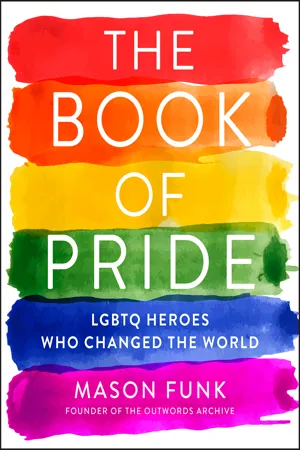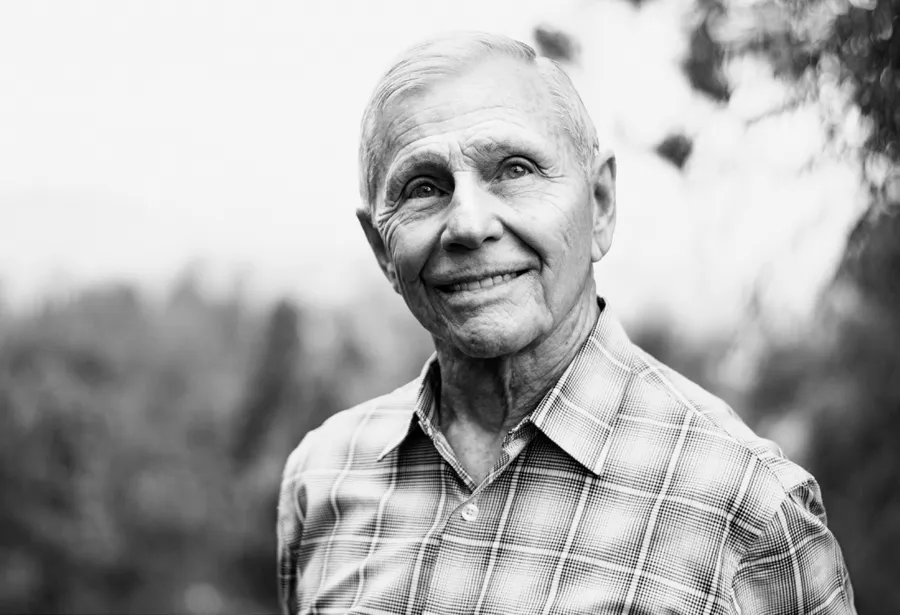Alexei Romanoff
UKRAINIAN IMMIGRANT, ACTIVIST
LOS ANGELES, CALIFORNIA
Alexei Romanoff was born in the Ukraine in 1936, fled with his family to the United States during World War II, and came of age as a gay man in New York’s Greenwich Village during the 1950s.
By 1966, Alexei was co-owner and manager of a Los Angeles gay bar called New Faces. On New Year’s Eve, New Faces, the nearby Black Cat, and two other gay bars were raided by the police. Six weeks later, Alexei helped organize a protest at the Black Cat. Taking place more than two years before the Stonewall riots of June 1969, many people regard this event as the true genesis of the modern gay rights movement.
A lifelong activist, Alexei worked to establish gay-friendly medical clinics, fought against California’s anti-gay Briggs Initiative, fought for AIDS research funding, helped convince Alcoholics Anonymous to list LGBT meetings, and cofounded the Avatar Club of Los Angeles to promote safer sex education for the leather community. In 2017, Alexei served as Grand Marshal of the Los Angeles Resist March, which took the place of that year’s traditional Pride march.
When I was sixteen or seventeen, in New York City, it was really hard to rent a place for two men. Two women could rent together, but they would not want to rent to two men, particularly in the Village, of all places. I had this partner and we saw an advertisement for an apartment with a view of the river. It didn’t say East River. It didn’t say Hudson River. Just “view of the river.”
We went and looked at it. The view of the river was, if you went out to the fire escape and hung over about two feet, you could see about two inches of the river way down there. But we liked the place. We talked to each other. We talked to the landlord and said we’d like to take it.
The landlord said, “What’s the relationship between you two?” I stopped for a minute and I stuttered and I said, “He’s my partner and my lover.” I looked back at my boyfriend and he was looking at me with his mouth hanging open and eyes wide as though to say, “What the hell have you just done?”
The landlord then said to me, “Can you guys afford the place?” I said, “Yes, we have your first month’s rent here. We both work part-time. We’re going to the university. I sit out on the street on weekends and sell my artwork, and I study.” He said, “Okay, give me the first month’s rent. Here’s the keys.”
PRIDE (Personal Rights in Defense and Education) led hundreds in protest of the riots that occurred when police raided the Black Cat and other bars in the Silver Lake neighborhood of Los Angeles and brutally beat patrons and the bartender. February 11, 1967.
With permission from ONE Archives
To this day, I have never lied. To this day, if someone asks me, I tell the truth.
FACE DOWN ON THE SIDEWALK
I arrived in Los Angeles on February 15, 1958. Eventually, I was working in a bar called the High Spot. It was on Hyperion Boulevard down in Silver Lake. Evidently, my reputation got out as being friendly, because I’ve always been a talker and a person who likes to meet new people. In 1964, this woman, her name was Lee Roy, came over to the High Spot and she said, “I’m trying to open a bar here on Sunset Boulevard. We’ve already got the place rented. I would like you to come and help me set it up.”
I thought it was a really good thing. Lee ended up giving me part-ownership of the bar for helping to set it up. That’s how I got involved in New Faces.
On New Year’s Eve 1966, the police raided another bar up the street called the Black Cat. After they played “Auld Lang Syne” and everybody was hugging and kissing, that’s when the raid started. These people ran out of the Black Cat and ran down the block to New Faces. The police followed them. Of course, they were plainclothes. They weren’t uniformed officers. Evidently, they saw somebody who ran away from the Black Cat in a white dress.
The people from the Black Cat ran into New Faces, and the police followed them in. Because it was New Year’s Eve, Lee Roy was dressed in a white gown. The cops said, “Who is the owner of this place?” The bartender said, “Lee Roy,” which sounded like a man’s name, and pointed at Lee. The cops went over and grabbed her and started beating her because they thought she was a cross-dresser. They broke her collarbone. Then the bartender came over, and they grabbed him and they pulled him across the bar. He had a ruptured spleen. Both Lee and the bartender ended on the sidewalk outside, face down. When they found that Lee wasn’t a cross-dresser, they didn’t press any charges on her. Both she and the bartender ended up in the hospital.
FROM BUNKER HILL TO THE BLACK CAT
After the events of New Year’s Eve 1966, a demonstration took place at the Black Cat, in February 1967. The Black Cat had the most damage from what had happened on New Year’s Eve. We made a lot of signs. We made flyers at a printing store because nobody had printers. If someone dropped a flyer, we would run and pick it up so that the police couldn’t bust us for littering. We kept moving so the police couldn’t bust us for loitering. It was five to six hundred gay men and women, lesbians, and those who support us. We marched up and down and chanted.
We were afraid the news media would show. We were afraid because if our pictures were in the paper, we would lose our jobs. We would lose our homes. None of the mainstream media showed up, but the free press showed up. They covered it with the pictures, all the pictures we have today. Years later, I met with Chief Bill Bratton of the Los Angeles Police Department. We were looking at the pictures from the demonstration. I said to him, “Do you see anybody smiling?” He looked at them and he said, “No.” I said, “They weren’t. They were scared as hell.”
About two years, we had the Black Cat designated a historical landmark. An Asian man led that charge. His name was Wes Joe. He’s still around today. I was asked why I wanted this place declared a historical landmark and a plaque put outside. I said, “Just like you have Bunker Hill, you have Gettysburg, you have Selma, Alabama. Some young gay man who’s maybe eighteen, when I’m no longer here and able to tell him what had happened, he has a place to go to that’s a physical place with a plaque outside. That’s why we need that. We need to remember where we came from.”
Today, Alexei lives with his husband, David, in Los Angeles. With his twinkling blue eyes, it’s easy to imagine Alexei as a Ukrainian immigrant charming the pants off New York queers in the 1950s. But Alexei’s fighting spirit is never far away—it’s what has kept him going all these years.



